

Are you tired of wasting precious sewing time rummaging through a chaotic mess of patterns? It’s time to put an end to the frustration and revolutionize your sewing pattern storage.
In this article, we will reveal 15 genius hacks that will transform your sewing space into an organized oasis, allowing you to enjoy a more efficient and enjoyable sewing journey. From digital storage options to practical storage solutions, we’ve got you covered. Say goodbye to clutter and hello to a world where your patterns are easily accessible and beautifully organized.
[ This post probably contains affiliate links, our full disclosure policy is boring, but you can read it HERE ]
Utilize Digital Storage Options
Embrace the power of digital storage options. With technology at our fingertips, it’s easier than ever to digitize and organize your patterns in a way that is efficient.
Consider creating a system that works best for you. You can categorize them by garment type, designer, or even fabric type to make retrieval a breeze. Adding descriptive file names and tags can further enhance the organization, allowing you to quickly locate patterns based on specific criteria, such as the silhouette or difficulty level.
If you’re concerned about losing or damaging your digital patterns, there are a few precautions you can take. Regularly backing up your files on an external hard drive ensures that even in the event of a computer failure or accidental deletion, your patterns will be safe.
Storing your patterns in the cloud, such as using services like Dropbox or Google Drive, adds an extra layer of security and convenience, as you can access your patterns from any device with internet access.
Digital storage also opens up exciting possibilities for sharing and collaborating with fellow sewing enthusiasts. You can easily send patterns to friends, participate in online pattern swaps, or even join virtual sewing communities where members exchange digital patterns. The digital realm provides endless opportunities to connect with like-minded individuals and explore new designs, all while keeping your sewing space clutter-free.
RELATED: DIY Cactus Pillow Sewing pattern
RELATED: The Best DIY Cube Storage Makeover: A Stylish Room Accent
Invest in Practical Solutions to store Paper Sewing Pattern
By incorporating practical storage solutions into your sewing space, you can create a more streamlined and efficient setup that will enhance your overall sewing experience.
Magazine holder
One practical storage solution that can vastly improve your sewing pattern organization is a magazine holder. Magazine holders are not just for holding magazines—they can also be repurposed to neatly store your sewing patterns. With their slim design and upright positioning, magazine holders allow you to easily sort and access your patterns without the need to dig through a messy pile.
Imagine having all your patterns neatly arranged in magazine holders according to categories such as tops, dresses, skirts, or even by season. No more wasting time searching through stacks of patterns or misplacing your favorite designs.
Consider labeling each holder with the category of patterns it contains. This simple step will further enhance your organization system and make it even easier to find the pattern you need at any given time. You can use adhesive labels, printable labels, or even hand write the categories directly on the holders. Whichever method you choose, the key is to create a system that works for you and helps you stay organized.

DIY Magazine files (Free template)
Plastic folders and sheets
Speaking of clever storage ideas, plastic folders provide an additional level of organization and protection for your sewing patterns. This storage solution allow you to organize your patterns in a way that keeps them neat, tidy, and easily accessible.
One of the great advantages of using plastic folders and sheets is that they come in various sizes, allowing you to tailor your storage to fit your specific needs. You can find folders that are large enough to hold multiple patterns, or smaller ones that are perfect for individual patterns. This flexibility ensures that you can customize your storage system to accommodate any number of patterns and keep them organized.
In addition to their size options, plastic folders and sheets also offer the benefit of protection. These folders are made from durable materials that shield your patterns from dust, moisture, and other potential hazards. You can rest assured that they will stay in pristine condition, even if they are stored for extended periods of time.
Another advantage of using plastic folders and sheets is their transparency. Many of these folders are clear, allowing you to easily see the patterns stored inside without having to open each folder. This quick visual reference makes it effortless to find the pattern you need without rummaging through a stack of folders.
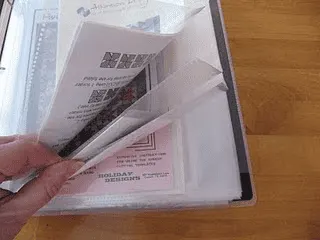
Pattern organization with plastic folder and 3 ring binder

Hooks or clothes rack
Hooks or cloth racks are excellent options for storing your sewing patterns, especially if you have limited shelf or drawer space. By utilizing vertical space, you can free up valuable storage real estate and create a more organized sewing area.
To hang your patterns on a hook, just punch a hole in a corner of the sewing pattern, pass a ribbon or a twine and make a knot.
One way to incorporate hooks into your sewing pattern storage is by hanging your patterns on individual hooks. You can easily find small hooks that can be screwed, or glued, into the wall or attached to the inside of a cabinet door. This method is perfect for patterns that are frequently used or those that you want to keep within arm’s reach. By hanging them up, you’ll save time searching for specific patterns and avoid any creases or wrinkles that may occur when patterns are folded and stored.
If you have a larger collection of patterns, clothes racks can be a game-changer. These freestanding racks typically come with multiple arms or tiers that can hold a significant number of patterns. Clothes racks are versatile and can be placed in any corner of your sewing room.
By utilizing hooks or cloth racks, you can easily display and access your patterns without sacrificing precious workspace.
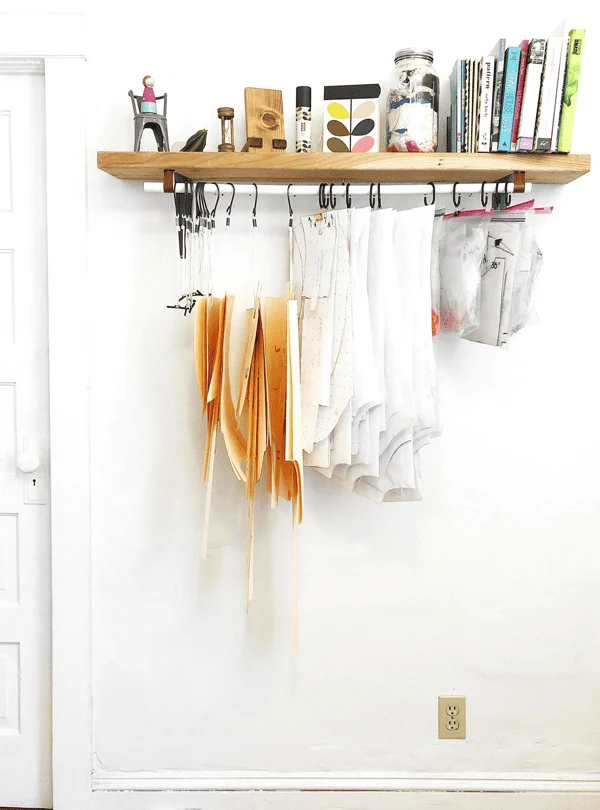
Hanging Sewing pattern storage
Envelopes and Cardboard folders
If you prefer a more compact and space-efficient solution, these storage options are perfect for you. Envelopes are great for storing individual patterns, while cardboard folders can hold multiple patterns in a neat and organized manner.
Envelopes come in various sizes, allowing you to choose the one that best fits your patterns. You can easily label each one with the pattern name or number, making it a breeze to locate the pattern you need when inspiration strikes.
On the other hand, cardboard folders provide a larger storage capacity. You can stack multiple patterns in one folder, ensuring that they stay together and minimizing the risk of misplacing or losing any of them. These folders often have tabs or dividers, allowing you to categorize your patterns by type, size, or any other system that works for you. With cardboard folders, you can keep your patterns neatly organized and easily accessible whenever you need them.
By utilizing envelopes and cardboard folders, you can efficiently maximize your sewing pattern storage while maintaining a clutter-free workspace. These storage options are not only practical but also budget friendly.
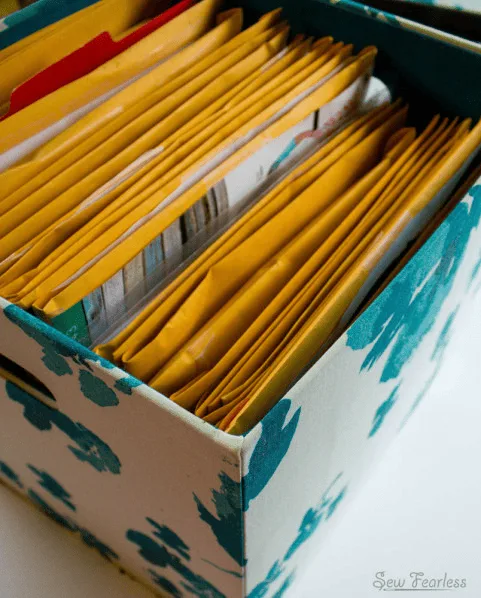
Organizing Sewing pattern with envelopes
Use Paper Clip to organize your Sewing Patterns
Did you know you can use paper clips to store and hang your sewing patterns? It’s a cheap option. All you need to do is combine your pattern pieces and clip them together.
Make sure to print out your pattern instruction page so you can quickly see the pattern when you’re looking through your collection.
Use the clip loop to hang your patterns on a hook, a nail or slide it on a hanger and store them in a closet. Quick and simple way to organize your patterns.

Organizing pattern with paper clips
Zip lock bags
With their transparency and versatility, zip lock bags offer a convenient way to store and protect your patterns while allowing for easy identification.
Zip lock bags are a simple yet effective solution for keeping your sewing patterns organized. The clear plastic material allows you to easily see what’s inside without having to open each bag, saving you valuable time and effort. Plus, it helps to protect your patterns from dust, moisture, and potential damage.
They come in various sizes, so you can choose the ones that best fit your patterns.
To make your zip lock bag storage even more efficient, consider labeling each bag with the pattern name, size, and any additional notes. This way, you can quickly find the pattern you need without having to search through a pile of bags. You can use adhesive labels or simply write directly on the bags with a marker.
Another great advantage of using zip lock bags is their portability. If you often take your sewing projects on-the-go or attend sewing classes, you can easily grab a few patterns in zip lock bags and toss them in your bag. This way, you’ll always have your patterns neatly organized and ready to use wherever you go.

Sewing Pattern ziplock storage idea
Rolled up
Roll up the patterns and store them in a large basket, a bin or a bucket. Print the cover or the pattern diagram and wrap the image around the pattern pieces. This will allow you to easily find the pattern once stored. Tie the rolled pattern with a piece of rope or ribbon.
You can also create a label from an empty toilet paper roll. Cut the roll lengthwise and wrap it around the pattern pieces to hold them together. Write the pattern references on the outside of the roll, you can also use stickers or colored markers to differentiate the types of clothing.

Rolled up pattern storage idea
Pants hangers
Pants hangers, typically used for hanging trousers or skirts, can also be repurposed to keep your sewing patterns organized. Simply hang your pattern from the hanger. The wide clips on the hanger will securely hold it in place, preventing your patterns from getting lost or damaged.
One of the great advantages of using pants hangers for pattern storage is their versatility. You can easily group patterns together by project or type by using separate hangers for each category. For example, you can have one hanger dedicated to dress patterns, another for tops, and another for accessories.
Additionally, pants hangers can be hung on a clothing rack or inside a closet, taking advantage of vertical space and freeing up valuable shelf or drawer space. This is especially useful if you have a small sewing room or limited storage options.
The clear advantage of using pants hangers is the visual aspect. Unlike storing patterns in boxes or bags, hanging them on pants hangers allows you to see the patterns at a glance. This can save you time and effort, as you won’t have to sort through numerous containers or folders to find the specific pattern you’re looking for.

Pattern organization with pants hangers
Storage box
Storage boxes provide a versatile and practical solution for organizing your sewing patterns.
With a designated box for each pattern collection, you can quickly locate the specific design you’re looking for. Gone are the days of frantically rummaging through piles of patterns or wasting time searching through multiple containers.
Boxes also provide optimal protection for your patterns. Made from sturdy materials such as plastic or cardboard, these boxes shield your patterns from any potential harm.
Depending on the size and shape of your patterns, you can choose from a range of box options. Compact and stackable boxes can maximize your space efficiency. The flexibility of storage boxes allows you to tailor your storage solution to your specific sewing patterns, ensuring a seamless and adaptable system.
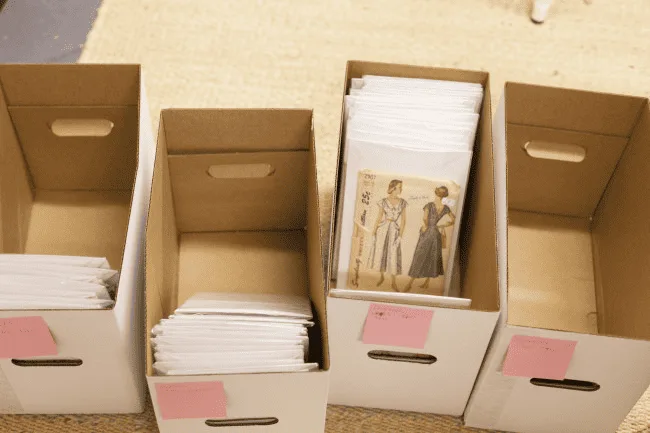
How to organize sewing patterns in boxes
Spinning rack display
Another original idea for storing your patterns is to organize them in a spinning rack.
Gather each pattern and place the pieces in an envelope or ziplock and use a paper clip and hang them on the display.
You will find the pattern you are looking for at a glance. The racks are often mounted on casters so they are perfect to place in an empty corner of your room.
You can easily find a spinning rack online, or even for free when stores close or change their layout.

Store Patterns in Cubbie
Cubbies are always a good idea to optimize storage. This is obviously a good option for organizing your sewing patterns.
What’s interesting about this storage idea is that you can combine storage for your sewing patterns and fabrics in the same piece of furniture, what a great way to optimize your sewing space.
The cubbies come in different sizes, choose what best suits your space and your storage needs.

Filing cabinet
Filing cabinets are a fantastic option for those who have a large collection of sewing patterns or want a more sophisticated storage solution. With multiple drawers and compartments, these cabinets provide a dedicated space for each pattern, making it easy to find exactly what you need without rummaging through a pile of patterns.
One of the key advantages of using a filing cabinet is the ability to categorize and label your patterns effectively. You can create different sections or drawers for various types of patterns. Within each section, you can further organize them by style, size, or pattern brand. By implementing a logical filing system, you’ll have a clear overview of your entire pattern collection at a glance.
If you’re concerned about the aesthetic aspect, fret not! Filing cabinets are available in a wide range of styles and finishes to suit any sewing room decor. Whether you prefer a sleek and modern look or a vintage-inspired design, there’s a filing cabinet out there that will complement your space perfectly.
A filing cabinet is a more pricey option to store sewing patterns. If you are on a budget head up to your thrift store or online to find a second-hand filing cabinet. Don´t hesitate to customize it with a fresh coat of paint to match your sewing room decor.
With its organization prowess and versatility, a filing cabinet is an excellent option for revolutionizing your sewing pattern storage.

Open Shelving Pattern storage
If you are an avid seamstress and need regular access to your sewing patterns, open shelving is a good solution.
Store the patterns in transparent pouches and organize them by category in clear plastic boxes.
You’ll always have your patterns at hand and will find what you’re looking for in no time.
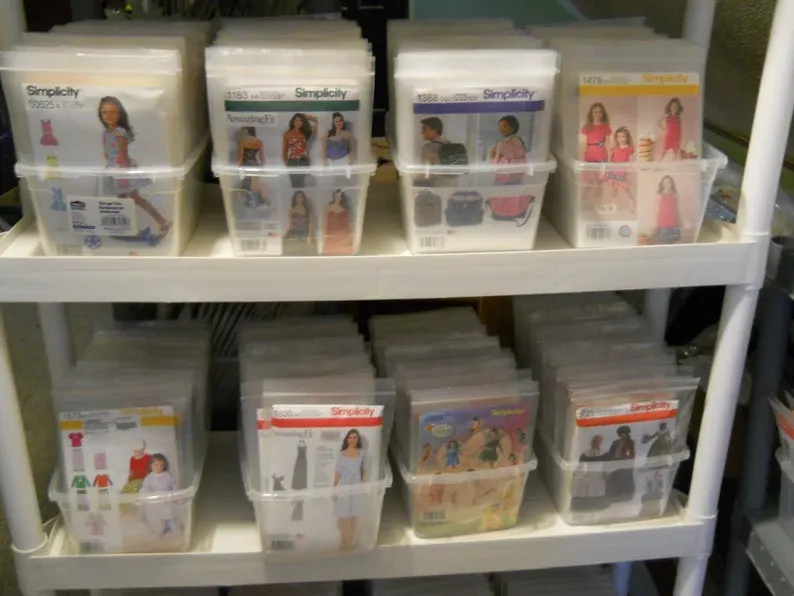
Clear bags to store sewing patterns
Dedicated Sewing patterns Drawer
By far the simplest solution for storing your sewing patterns. By setting aside a specific drawer solely for this purpose, you can truly revolutionize your storage system. No more digging through piles or rummaging through various containers – dedicated drawers provide a streamlined and organized space for your patterns.
The beauty of dedicated drawers is that they can be easily customized to fit your specific needs. You can use dividers or compartments within the drawer to separate different pattern types or sizes, making it effortless to locate the one you need. Additionally, you can label each section for further convenience, ensuring that you can find your patterns at a glance.
When it comes to choosing a drawer for your sewing patterns, consider factors such as size and accessibility. Opt for a drawer that is spacious enough to accommodate your pattern collection without cramming them together. Having enough room will prevent any damage or creasing of your patterns, ensuring they remain in pristine condition.

Concertina file
Let’s move on to our next genius hack: the concertina file. A a simple yet efficient solution for organizing and storing your sewing patterns.
Similar to the way a filing cabinet operates, a concertina file consists of multiple compartments or sections that expand and contract, allowing you to easily sort and categorize your patterns. The accordion-like design of the file makes it compact and space-saving, perfect for those with limited storage options.
To use a concertina file for your sewing patterns, start by labeling each section with the different categories or types of patterns you have. This could include categories such as tops, dresses, skirts, or even specific styles like vintage or contemporary. By categorizing your patterns, you’ll quickly be able to locate the specific design you’re looking for without rifling through a jumbled mess of papers.
Once you have labeled each section, it’s time to insert your patterns. Begin by placing them in the appropriate category, ensuring that they are neatly folded to fit within the file. If your patterns are on larger sheets, consider using paperclips or small binders to keep them organized and prevent them from slipping out.

RELATED: The best patterns to sew fabric baskets and bins
RELATED: Get Crafty this Christmas: 25 Amazing Christmas Stocking pattern Ideas
Categorize and Label Your Patterns
Categorizing your patterns according to different criteria will make it much easier for you to locate specific designs when you need them.
You can organize them by:
- Garment type
- Pattern company
- Difficulty level
Think about how you like to search for patterns and what makes the most sense to you personally.
You can create your own labeling system using colored stickers, or if you prefer a more streamlined approach, you can invest in printable labels specifically designed for pattern storage.
Ensure that your labels are clear and easy to read. Include relevant information such as the pattern name, the pattern company, and the garment type. You may also want to include any additional notes or modifications you’ve made to the pattern. This way, you’ll have all the essential information right at your fingertips.
Consider incorporating a color-coding system into your labeling strategy. Assigning each category a distinct color will add an extra layer of organization to your collection. For example, you could use green for tops, blue for dresses, and yellow for skirts. This color-coding system will not only make your patterns visually appealing but also help you quickly locate the patterns you’re looking for.
By categorizing and labeling your patterns, you’ll transform your sewing pattern storage into an efficient and user-friendly system. With a clear organization in place, you’ll be able to focus on what really matters – sewing and creating beautiful garments that bring your creative vision to life.
In conclusion, revolutionizing your sewing pattern storage is a game-changer for any avid seamstress.
So, start implementing these genius hacks today and embark on a clutter-free and efficient sewing journey. Remember, the key to unlocking your sewing potential lies in a tidy and curated collection of patterns. Happy sewing!
Want to remember it? Save these Sewing Pattern Storage ideas on your favorite Pinterest board.

Amaryllis
Credit : Source Post






